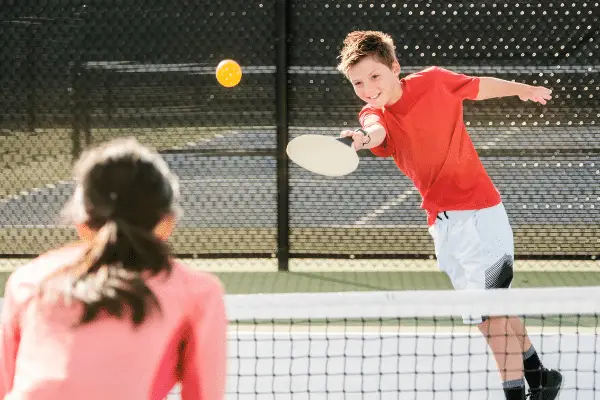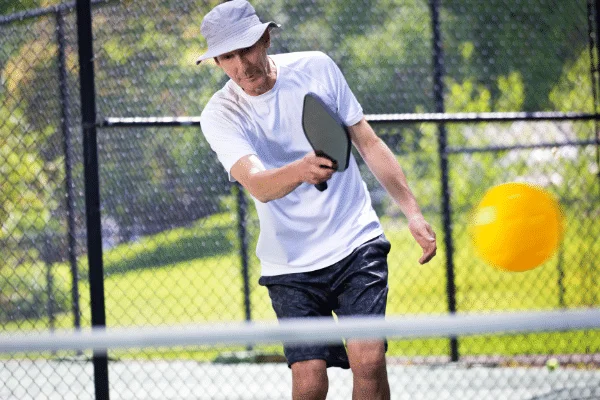Pickleball is a fun sport that combines the elements of ping-pong, tennis, and badminton. While doubles pickleball is most commonly played, singles pickleball is quite popular too. Although it gets challenging, there’s no denying that it’s fun and helps improve your playing skills. Read on to know more about pickleball singles.
Rules of Pickleball Singles
While playing pickleball singles, one player plays on each side of the net and is responsible for covering the entire side of the pickleball court. This is more physically demanding as you’ve got to cover your whole side of the court, meaning quick movements, lateral shifting, and quick transitioning from any part of the court to return the ball.
- Each player has only one serve attempt. This is similar to the doubles game, where the serving team also has only one serve.
- In pickleball singles, there’s no need for the third number in the score since there’s no second server. The score will be two numbers only; the first is the server’s score, and the second is the receiver’s score.
- The first serve always starts on the even/right side of the court. If the server wins, the serve is kept, and the server serves by switching to the other side of the court. However, if the server commits a fault, the server loses the serve.
- The games are played for 11 points, and the player with a two-point margin wins.
- The serving side scores points when the opponent faults.
Related post: Top 10 singles pickleball strategies
Player Positioning
The player who serves first must always start on the even/right side of the court. To determine the correct side, the score of the pickleball game is considered:
- For an even score of the server, the serve must be from the even/right side of the pickleball court, served to the receiver’s even/right side of the court.
- If the server’s score is odd, the serve must be from the odd/left side of the court and served to the receiver’s court’s odd/left side.
Serving
The rules that apply to a pickleball singles serve are more or less similar to that of a serving team and receiving team playing doubles pickleball.
Serving Rules
- The serves must be made diagonally crosscourt, ensuring the ball lands in the permitted area of the opposite diagonal court. As per the service rule, the paddle must touch the ball below the server’s waist, and the serves must be underhand.
- The server must stay behind the baseline until the ball is hit; neither foot must touch the baseline or the court.
- The ball must be hit into the air without bouncing. The diagonal serve must clear the non-volley zone line.
- While a single-serve attempt is permitted, in case of a let (when the ball hits the top of the net while still landing in the proper service court), the serve can be re-attempted.
Related post: How to serve in pickleball
How to Determine First Serve in Pickleball Singles
Typically, a coin toss determines the first serve. The toss winner gets to decide which side to play from and whether to serve or receive. Any other fair method can be used to determine the same.
Serving Sequence
The basic pickleball rules singles serving sequence differ from a serving doubles team.
- Each side’s first serve always occurs from the even/right court.
- The server continues serving while alternating service courts. On scoring a point, the server switches sides and takes the next serve from the other side.
- The server continues serving until the server faults. In this case, the service passes to the opponent, and the court’s side for the next serve is based on the opponent’s score.
- If the server is in the wrong position, it’s considered a fault, leading to the server losing the rally.
Scoring Rules
- Only the server is awarded points.
- Games are played for 11 points, and the win is determined by a lead of two points.
- Often, tournament games get played to 15 or 21 points, with a win of two points.
- The best of three games is considered for each match, with the third game being played for five points, winning by two.
Related post: Best books on Pickleball
Faults
When there is a rule violation, it leads to a fault. The server gains a point when the opponent makes a fault. However, the server loses the serve or side out if there is a server’s fault. The same rules apply to a pickleball doubles game.
A fault occurs when the ball:
- Gets hit beyond the bounds.
- Gets hit into the net on a serve or a return.
- Is in the non-volley zone and gets volleyed.
- Is volleyed before the mandatory bounce on each side.
- Is served and touches the non-volley zone or the non-volley zone line.
- Bounces twice before being returned by the receiver.
- Strikes a player or anything on the player.
- Strikes any object before bouncing on the court.
Additionally, a fault occurs if the player or the player’s clothing or paddle touches the net or the post when in play. If any of the service rules get violated, it counts as a fault.

Line Calls
A ball is considered to be ‘in’ only if it touches any line other than the non-volley line on a serve. It is short and a fault with the serve contacting the non-volley zone line.
Double-Bounce Rule
- This two-bounce rule applies only to the ball serve. The opponent must let the ball bounce on serving the ball before attempting to return it. This return must also have one ball bounce before the server returns it.
- After the first two returns, the subsequent hits can be struck before or after the ball bounces (ground stroke).
- The two-bounce rule extends rallies and eliminates the serve and volley advantage.
Volleying Rules
Volleying means hitting the ball before it bounces. Certain rules apply to volleying, about the court’s non-volley zone (seven feet around both sides of the net, marked by a line) or the ‘kitchen’:
- Volleying isn’t permitted in this zone, thus preventing smashes from near the net.
- It’s considered a fault when you step into the non-volley zone or even the line while volleying. Additionally, a fault occurs if anything you wear or carry touches the non-volley zone or the lines owing to the playing momentum.
- It’s a fault when your momentum takes you into the non-volley zone or gets you touching the line after volleying.
- You can play from the non-volley zone, provided you’re not volleying the ball.

Singles Strategies
Having to cover the entire side of your court will require some strategies to leverage a quick response and be able to hit different shots.
- Executing the serve near the centerline enables the server to cover both sides of the court effectively upon return of the serve. Conversely, the return will be difficult to reach if the server is closer to the sidelines.
- A short serve makes it easy for your opponent to return the serve deep into any corner. This will complicate your attempt for the following passing shot or drop shot. Instead, try hitting the serve big and deep into the opponent’s court, making it more difficult for the opponent to return to the non-volley line.
- More frequently, players have a weaker backhand than a forehand. Therefore, you can play strategically by attempting to get your opponent to use the weaker side.
- Try hitting deep shots into corners, just like in tennis, not giving your opponent the setup time. Also, this provides you with the opportunity to return to the non-volley line and take control of the point.
- Whenever possible, attempt the return-of-serve shot aiming for the non-volley line. Since the server will have to let the ball bounce before hitting, you will have the advantage at the line.
- The net is positioned higher at the post while it’s lower at the center. By using this knowledge to your advantage, you could play high-percentage pickleball.
- If your opponent is at the non-volley line while you’re at the baseline, you could play your next shot in a couple of ways. For a hard passing shot, you could hit the ball to cross the net and dip into the non-volley zone (with your opponent most likely hitting the next shot up) or hit a lob crossing over your opponent’s head (lob being the lowest percentage shot) when playing an advanced level player. Attempt a passing shot or a shot dipping into the non-volley zone.
Final Thoughts
Singles pickleball can be quite the workout to improve your fitness and conditioning and help you think more strategically on the pickleball court. Despite the court size being much smaller than a tennis court, there’s still a lot of ground that needs to be covered while rallying.
While it’s easy to get used to, it could be quite difficult to stop playing singles pickleball once you’ve taken a liking to it, especially since the rules of pickleball singles are similar to that of doubles.

